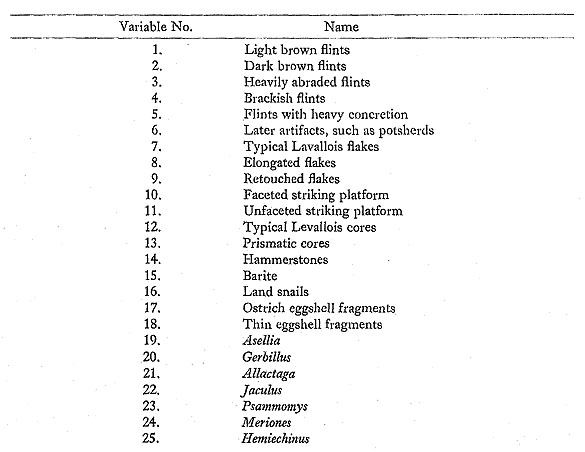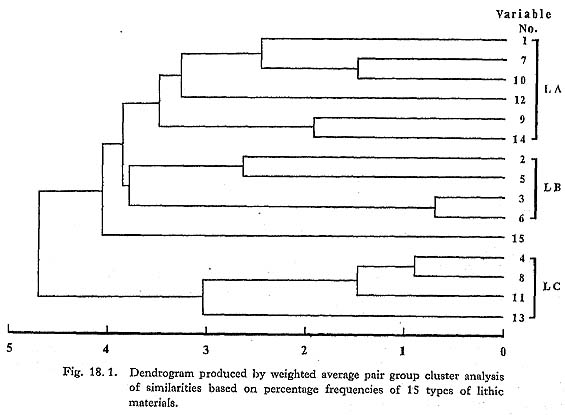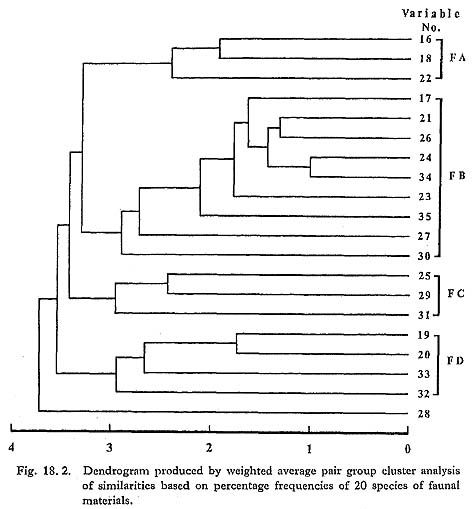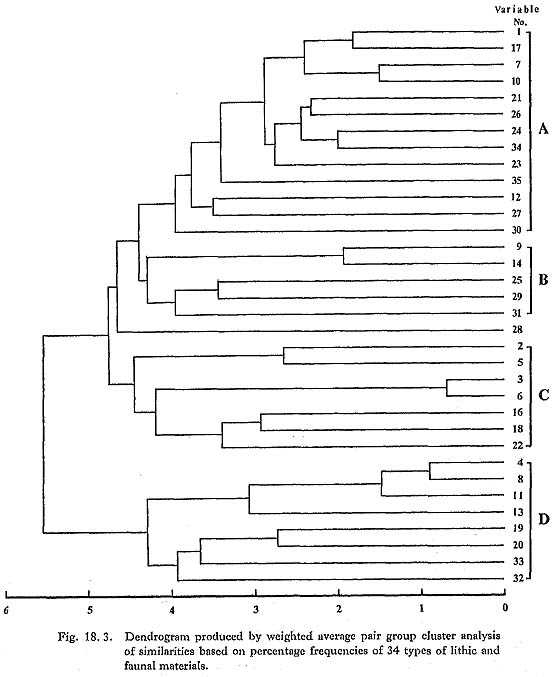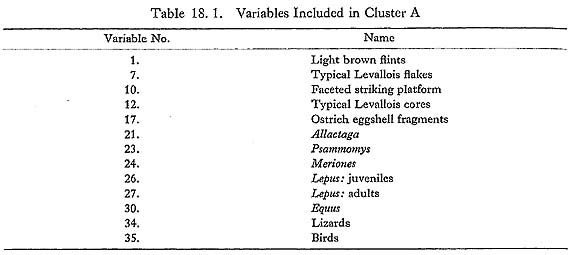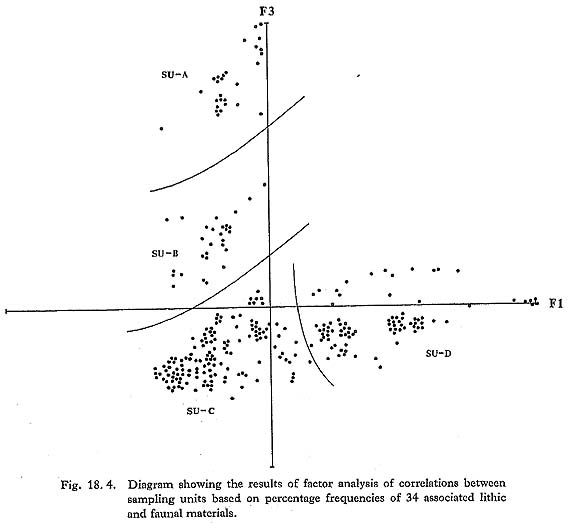CHAPTER 18
Statistical Analysis of Articulation Net among the
Sampling Units: A Progress Report
Takeru Akazawa
Department of Anthropology and Prehistory,
The University Museum, The University of Tokyo
and
Kazuro Hanihara
Department of Anthropology,
Faculty of Science, The University of Tokyo
18. 1 INTRODUCTIONWe have presented considerable new evidence in the field of Quaternary studies in the Levant through two seasons' excavations at Douara Cave in 1970 (Suzuki and Takai, 1973, 1974) and 1974 (Hanihara and Sakaguchi, 1978; Hanihara and Akazawa, 1979). These studies concentrated upon sediments and the associated lithic assemblages of the cave, however. In other words, faunal remains, another major constituent of the deposits, were excluded from the preceding studies, except for Takai's description of the 1970 season's material (Takai, 1974). This fact presented an obstacle to a comprehensive understanding of human habitation patterns and their relation to the environment of the cave. In this volume, Sebastian Payne has analyzed the whole collection of faunal remains from the 1974 excavations. Thus, the Douara Cave has become one of the few sites in the Paleolithic field at which systematic sampling techniques were used to recover all the material from the excavated areas and the identified faunal species have been described both quantitatively and qualitatively. According to the identification results, Payne has discussed paleoenvironmcntal conditions of the site and the surrounding areas during the Middle Paleolithic, as well as man's relationship to this environment. His discussion was based mainly on the faunal species of the cave, although some other data were also utilized. The aim of this chapter is to discuss the relationship between the two major constituents of the cave-the lithic and faunal assemblages. We propose a new research method articulation net analysis-as an approach to archeological studies into the meaning of the inter-correlations of materials within the deposits. The chapter is divided into four sections. First, the techniques and methods used in the present study are explained, and the materials that were used are defined. Second, the analytical results are presented. This section focuses on the differing conbinations of lithic and faunal materials in the deposits. The third section focuses on the clustering of excavation units due to the combination of materials, and the concluding section discusses the relationship between the stratigraphic data of the deposits and articulation among the sampling units. 18. 2 EXPLANATION OF METHODThe objective of this study is to examine distribution patterns of lithic and faunal remains and their differing combinations in the deposits. The material utilized here is composed of two series of collections: One is the lithic assemblage described in the last excavation report (Akazawa, 1979), and the other is the faunal assemblage described in this volume (see Chapter 15). Both are from the 1974 season's collection. In our last excavation at Douara Cave, we followed a grid system of 1 × 1 m. Thus, the deposit of the cave was divided into square columns, according to the grid. Each square column was then divided vertically at intervals of 10 cm. These sampling units were de signed in the three trenches at the cave. In this way, a total of about 400 sampling units were removed. The sampling units analyzed here, however, are restricted to the deposit yielding the Middle Paleolithic assemblage from the top to the bottom of the last excavations. That is, the deposit distributed in the exterior of the cave was excluded from the present analysis, since the uppermost deposit in this region is composed of Epi-Paleolithic deposit, yielding very few faunal remains, as mentioned by Payne. A total of 285 sampling units were an alyzed. Articulations among these sampling units were calculated, based on the 35 variables listed below:
Actual calculations were made according to the percentage frequencies of these variables. The frequency of each faunal species was calculated back from the diagrams made by Payne (Figs. 15. 41—44, 46—52, 54—56). In the pursuit of the study, computer-assisted, multivariate programs were employed. First, average-linkage cluster analysis, with the Euclidian measure, was selected for the purpose of clustering the related variables. Second, factor analysis was used to find the sim ilarities and dissimilarities between the sampling units. These computations were pro cessed by the HITAC M-280H/M-200H system of the University of Tokyo Computer Centre, using the programs BMDP2M for the clustering analysis and BMDP4M for the factor analysis. 18.3 RESULTS18. 3.1 Combination of lithic artifactsFigure 18. 1 shows the cluster diagram of 15 variables (Variable Nos. 1-15) selected from the lithic remains of the cave. A dendrogram was produced by the weighted average pair group method.
In the dendrogram, the forms fall into two main groups-the first consists of eleven variables, and the second consists of four variables, grouped as LC (4, 8, 11, 13). Within the first group there is a division into three subgroups: LA (1, 7, 9, 10, 12, 14), LB (2, 3, 5, 6), and 15. 18. 3. 2 Combination of faunal speciesFigure 18. 2 shows the cluster diagram of 20 variables (Variable Nos. 16-35) selected from the faunal materials identified. The dendrogram was produced by the same method as that used for the lithic material.
In the dendrogram, the forms fall into five major groups-the first consists of three variables grouped as FA (16, 18, 22), the second nine variables grouped as FB (17, 21, 23, 24, 26, 27, 30, 34, 35), the third three variables grouped as FC (25, 29, 31), the fourth four variables grouped as FD (19, 20, 32, 33), and 28. 18. 3. 3 Combination of whole variablesFigure 18. 3 shows the cluster diagram of the whole group of variables that were analyzed in the preceding two sections. In this case, barite (15) is excluded from the analysis, since it is uncertain whether or not it is artificial material.
In the dendrogram, the total 'forms fall into two major groups-the first consists of twenty-six variables, and the other eight variables are grouped as D (4, 8, 11, 13, 19, 20, 32, 33). Within the first group, there is a division into four subgroups: A (1, 7, 10, 12, 17, 21, 23, 24, 26, 27, 30, 34, 35); B (9, 14, 25, 29, 31); C (2, 3, 5, 6, 16, 18. 22); and 28. Tables 18. 1 to 18. 4 show the differing combinations of variables included in the four clusterings, except for 28.
From these well-defined clusters, we can postulate the possibility that intercorrelations of lithic and faunal remains can be observed in certain groups of sampling units, at least in the deposits analyzed here. Further, it may be possible that a certain group of sampling units characterized by the same pattern of lithic and faunal combinations had a similar kind of depositional context. Next, we examine the clustering of the sampling units based on associated lithic and faunal assemblages. 18. 4 ARTICULATION AMONG SAMPLING UNITSTaking the same data used in the preceding sections, factor analysis was performed by pairing 285 sampling units. Figure 18. 4 shows the distance between the sampling units delineated by the factor scores calculated for each sampling unit on the basis of factor analysis. An examination of this figure shows that the forms fall into two main clusters: the first lies in the left half of the axis, and the second lies in the right half of the axis, designated as SU-D. Within the first cluster there is a division into three subclusters SU-A, SU-B, and SU-C.
Figure 18. 5 shows the separation of the analyzed sampling units drawn by the results mentioned above. The sampling units grouped as SU-A and SU-B are concentrated in the uppermost part of the deposits, whereas, the sampling units grouped as SU-D lie in the lowest part of the deposits. Between these two groups of sampling units are distributed the sampling units grouped as SU-C. On closer examination of these separations, through the original data and the differing combinations of variables mentioned earlier, each group of the sampling units can be explained according to diagnostic variables.
The sampling units distributed in the uppermost part of the deposits can be extracted by variables included in Cluster C. These sampling units are generally characterized by incidence of post-Paleolithic artifacts, such as potsherds, fragments of glass- and bronze made artifacts, and heavily abraded flakes patinated to a dark brown color. These charac teristics of the flints, including later artifacts, more or less suggest contamination of the deposits. This interpretation does not contradict the fact that these sampling units are concentrated in the uppermost part of the deposits. Land snails, thin eggshell fragments, and Jaculus, that is, faunal species diagnostic to this cluster, may not be primary con stituents of the deposits. The sampling units distributed in the lowest part of the deposits can be extracted by variables included in Cluster D. The lithic combination characterizing these sampling units is made up of elongated flakes and prismatic cores with unfaceted striking platforms patinated to a brackish color. Associated faunal species consist of Asellia, Gerbillus, Gassella, and Caprini. The variables included in Cluster A represent the largest number of sampling units distributed in the central part of the deposits. This combination of variables is also the largest in number, compared with other clusters of variables. The lithic assemblage is characterized by typical Levallois flakes and cores with faceted striking platforms. These flints are generally patinated to a light brown color. In association with these characters, a large number of ostrich eggshell fragments were found, and their distribution shows the same pattern as that of the lithic combination mentioned above. In addition, seven kinds of faunal remains-Allactaga, Psammomys, Meriones, Lepus, Equus, lizards, and birds correspond to this group of variables. From the distance analysis of variables, we found variables included in Cluster D con sisting of retouched flakes and hammerstones, and Hemiechinus, Vulpes vulpes, and Camelus. Nevertheless, we could not find any clear cluster of sampling units separated by these variables. On closer examination of the sampling units made up of these variables, through the original data, it appeared that most of them constitute the same group as the sampling units designated as SU-C. This result does not contradict the fact that this group of vari ables made up the same group of variables included in Cluster A and connected with SU-C sampling units (see Fig. 18. 3). 18. 5 FURTHER CONSIDERATIONSThe stratigraphic units determined in the 1974 excavations at Douara Cave consist of four Horizons: I, II, III, and IV. The complete sequence of these stratification has been described by Endo (1978). Of the four Horizons, I, III, and IV correspond to the sam pling units examined here. According to previous descriptions (Akazawa, 1976, 1979; Endo, 1978), these Horizons may be broadly defined as follows: 18. 5.1 Horizon IThe First Horizon denotes the uppermost deposit that covers the entire excavation area. The deposit is brackish to dark brown sediment, composed mainly of animal feces, with some boulder-shaped rubble. The collection of artifacts from this horizon is not homogeneous. Although it is a thin deposit, it contains a small number of Epi-Paleolithic as well as a large quantity of Levan tine Middle Paleolithic artifacts, in addition to some potsherds and some glass and bronze fragments that presumably belong to the Islamic age. All these materials are more or less abraded, and a large number of lithic artifacts are broken and usually patinated to very dark brown as a thermal action. 18.5.2 Horison IIIThe Third Horizon is also distributed throughout the excavated area. The deposit is characterized by brownish sediment, composed mainly of sand and silt, and is inter calated by some rubble and ash layers in places. Horizon III is subdivided into two Units, A and B. Unit A of Horizon III is more or less dark brownish sediment distributed next to Horizon I in the portion of the deposit, except for the part designated as Horizon II. The underlying Unit B of Horizon III consists of light brown to brown sediment, dis tributed throughout the excavated areas. The boundary between Unit A and Unit B is not very clear, but the underlying sediment is more homogeneous and compact than the upper section. The lithic assemblage of Horizon III has generally been classified as the Levantine Mousterian type, which has been described in numerous Levantine Paleolithic sites. The morphological features of the flakes and cores are generally seen to match up entirely with those of all types of Levallois elements in the Levantine Mousterian assemblages described so far. Although the difference between the two assemblages, IIIA and IIIB, was not clearly distinguished, the flint material from the underlying IIIB assemblage was patinated to a lighter color. These differences are similar to those in sedimentary color between the two stratigraphic units. 18. 5. 3 Horizon IVThe Fourth Horizon is characterized by dense ash deposits, in association with a large scale Middle Paleolithic hearth. Between Horizons III and IV there is a widespread con centration of weathered limestone fragments. Numerous ostrich eggshell fragments were found in the deposits. These fragments tend to be concentrated in the overlying Horizon III, below which a very small number of ostrich eggshell fragments was found. It is clear that there was a considerable time gap between the formation of these two Horizons, based on the sedimentological characters outlined above. Horizon IV is also subdivided into Units A and B. Unit B is more compact and homo geneous than Unit A, and is characterized by the thick alternation between whitish to grayish ashy layers and brackish charcoal lenses. This alternation has a maximum thick ness of 60 cm around the center of the hearth. The lithic assemblages of this Horizon were quite different from those of the overlying Horizon. Although the frequency of the material from IVA is very small, the IVB as semblage is broadly characterized by two features: One is the nonprepared core technique, and the other is a strong tendency toward elongated flakes with plain and dihedral striking platforms. Because of these overall patterns of lithic technology, this assemblage is dif ferent from the Levantine Mousterian described so far, but exhibits a close relationship to the pre-Aurignacian industry, as shown in the frequent use of the nonprepared core technique and of the strong tendency toward elongated flakes. 18. 5. 4 Relationship between the articulation among sampling units and the stratigraphic data of the caveThe articulation among sampling units obtained from factor analysis is generally close to the stratigraphic horizons and their associated lithic assemblages. First, the articulation among the sampling units designated as SU-A and SU-B shows the same distribution pattern as that of the deposits defined as Horizon I. These sampling units were articulated by the variables included in Cluster C. Among the variables, all the items except the faunal ones coincide with the artifacts characterizing Horizon I. Second, the articulation of the sampling units grouped as SU-C broadly overlaps Horizon III. These sampling units were separated from the others by the variables in cluded in Cluster A, that is typical Lavallois flakes and cores with faceted striking platforms patinated to a light brown color. These features exactly match the characters of the lithic assemblage associated with Horizon III, particularly IIIB. Furthermore, the ostrich egg shell fragments that were a more frequent occurrence in this Horizon constitute a diagnos tic variable for the variables included in Cluster A. The final articulation of sampling units designated as SU-D shows the same distribu tion pattern of deposits described for Horizon IV, These units were articulated by vari ables included in Cluster D. The diagnostic variables of elongated flakes and prismatic cores with unfaceted striking platforms patinated to a brackish color coincide with the morphological features extracted from the lithic assemblages of Horizon IV, particularly IVB. Thus, the observed separation of the sampling units broadly agrees with the sorting of the cave deposits based on geologial and archeological criteria. Nevertheless, the question remains unanswered of why a number of sampling units were not well separated. For instance, numerous sampling units are scattered around the closely clustered ones des ignated as SU-A, SU-B, SU-C, and. SU-D in. Figure 18.4. These sampling units are shown as blank in Figure 18. 5. Many of them are located between the closely clustered group of sampling units, but some lie in the spaces between the clustered sampling units. The number of sampling units of this kind is rather large in the lowest part of the deposit. This phenomenon may be caused by the low frequency of lithic and faunal remains utilized here as variables. In contrast, the sampling units in the uppermost deposit, which are characterized by an abundance of variables, have shown a clear separation from the others. The next question concerns the lithic assemblages and their relation to faunal species. Intercorrelations of faunal species in the cave deposit were discussed by Payne. Their dis tribution patterns within the deposits fall into three main clusters, designated as Com ponents A, B, and C (see Chapter 15). The combination patterns of the species are not the same as those obtained from distance analysis. The most distinct difference between the two studies is the fact that the species con stituting Payne's Component C fall into three different clusters of variables: adult Lepus and Equus fall into Cluster A; Hemiechinus, Vulpes, and Camelus into Cluster B; and Gazella and Caprini into Cluster D. Payne states that these larger mammal bones do not show a clear pattern of small-scale concentrations, as is reflected in the distribution of bats and other smaller mammals. As far as the results obtained here are concerned, the larger mammals do show somewhat more specific concentration within the deposits. Never theless, this interpretation can obviously be criticized, because it relies on indirect evi dence, particularly that based on measurements calculated from the diagrams. The original data are not consistent with this interpretation of the relation between the lithic and faunal remains analyzed here. However, the objective of this paper is not to make a final interpretation based on ana lytical results, but to examine a research method that is new to the archeological field. As mentioned by Shiffer et al. (1978), "abundance" and "clustering" of archeological materials in the deposit are interesting to archeologists and are valuable characteristics for their studies. For actual analysis based on these features, however, we should have at hand research designs appropriate for studies both in the field and in the laboratory. It may be unsafe to argue whether or not the present work is one of several varieties of analytical method that can be used for studies on "abundance" and "clustering" of arche ological materials, since the analysis is still underway. Nevertheless, the evidence pres ented above may give some support to the possibility that the techniques and methods are of no little significance in the archeological field. LITERATURE CITED
|
